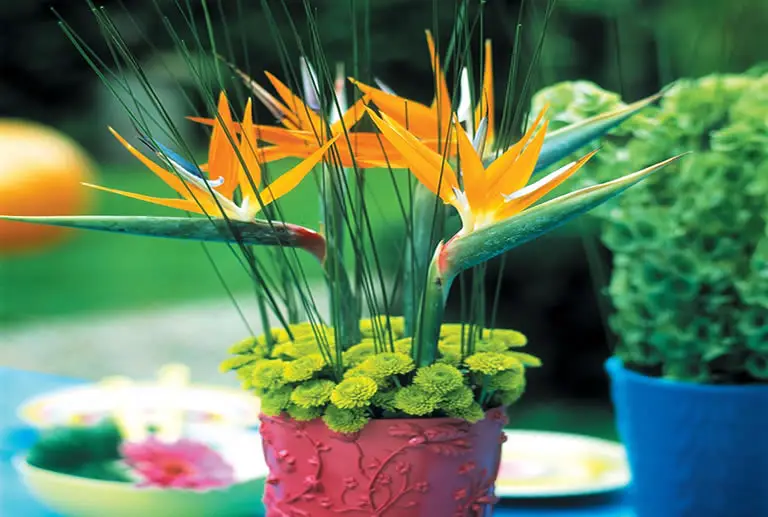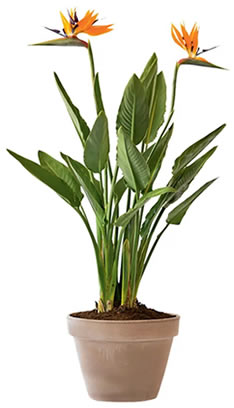Bird of Paradise Care: How To Grow This Iconic Tropical Statement Plant

The Bird of Paradise (Strelitzia reginae and Strelitzia nicolai) is one of the most dramatic and sculptural plants you can grow indoors or out. Known for its bold banana-like leaves and crane-shaped flowers that resemble a tropical bird in flight, this plant brings instant architectural elegance to any space. While flowering indoors is rare, its lush foliage alone is enough to make it a standout.
In this guide, you’ll learn exactly how to care for Bird of Paradise, including watering, lighting, fertilizing, and how to encourage fuller growth.
Table of Contents
- What Type of Plant Is the Bird of Paradise?
- Best Bird of Paradise Varieties for Home Growing
- Best Light Conditions for Bird of Paradise
- When and How Much To Water Bird of Paradise
- Best Soil Mix and Drainage Tips
- Ideal Temperature and Humidity Levels
- How and When To Fertilize Bird of Paradise
- Troubleshooting Common Issues
- Easy Maintenance To Keep Bird of Paradise Healthy
- When and How To Repot Bird of Paradise
- Growing Bird of Paradise Outdoors
- Final Word
What Type of Plant Is the Bird of Paradise?
Bird of Paradise is a tropical evergreen perennial native to South Africa.
It grows from a rhizome and produces large, upright leaves on long stems.
While commonly grown as a foliage houseplant, it can reach impressive heights — up to 6 feet indoors and even taller outdoors in warm climates.

There are two main types: Here are the two most popular Bird of Paradise types grown at home:
- Strelitzia reginae: Compact, colorful, known for orange and blue flowers.
- Strelitzia nicolai: Taller, white-flowering variety with a more palm-like appearance.
- These varieties differ mainly in size and flower color but have similar care needs.
Best Bird of Paradise Varieties for Home Growing
If you’re unsure which type to grow, these options are popular with both beginners and experienced plant keepers:
- Strelitzia reginae (Common Bird of Paradise) – Grows up to 6 ft indoors; produces iconic orange/blue flowers.
- Strelitzia nicolai (Giant White Bird of Paradise) – Can reach 8–10 ft indoors; produces white flowers with a more tree-like look. Each of these can be grown indoors with proper light and care, though flowering indoors is less common.
Best Light Conditions for Bird of Paradise
Bird of Paradise needs at least 6 hours of bright, direct or strong indirect light to thrive. Place it near a south- or west-facing window indoors. Outdoors, give it full sun.
Plants kept in low light may survive but will not grow robustly and are unlikely to flower.
Rotate the plant every few weeks to keep growth upright and even.
When and How Much To Water Bird of Paradise
Consistency is key.
This plant prefers moderately moist soil during the growing season, but not soggy.
Use the guide below to establish a watering routine based on the season and your growing conditions:
- Water thoroughly when the top 2 inches of soil feel dry.
- In spring and summer, this typically means once every 5–7 days.
- In fall and winter, reduce watering to every 10–14 days.
- Always empty saucers or cachepots to prevent root rot.
Large leaves drooping? That usually means it’s thirsty. Yellowing leaves? Likely overwatered.
Best Soil Mix and Drainage Tips
A good soil mix retains moisture but drains freely to prevent root issues.
Here’s a recommended blend:
- 2 parts indoor potting soil
- 1 part perlite or pumice
- 1 part compost or coco coir
Use a pot with ample drainage holes and consider terracotta to help wick away excess moisture.
Ideal Temperature and Humidity Levels
Bird of Paradise thrives in warm, moderately humid environments. Here’s how to meet its needs:
- Temperature: Thrives between 65–85°F (18–29°C). Avoid temps below 50°F (10°C).
- Humidity: Prefers moderate to high humidity. Aim for 50%+.
In dry homes, use a humidifier, pebble tray, or place the plant near other humidity-loving plants.
How and When To Fertilize Bird of Paradise
Regular feeding is important for growth, especially during spring and summer.
Follow these fertilizing tips for best results:
- Use a balanced liquid fertilizer with an N-P-K ratio of 10-10-10 like this one or 20-20-20 like this one.
- Dilute to half strength.
- Feed every 2 weeks from spring through early fall.
- Stop fertilizing in winter.
A slow-release fertilizer can also be used in spring for consistent feeding.
Troubleshooting Common Issues
If your Bird of Paradise isn’t looking its best, check for these common signs:
- Curling Leaves: Often caused by under-watering or low humidity.
- Leaf Splits: Normal and natural; helps the plant withstand wind in the wild.
- Yellowing Leaves: Usually overwatering or poor drainage.
- Brown Edges: Low humidity or salt buildup — flush soil every few months.
Address issues early to keep the plant healthy and encourage continued growth.
Easy Maintenance To Keep Bird of Paradise Healthy
Bird of Paradise benefits from regular maintenance to stay clean and vibrant.
Here are simple steps to include in your plant care routine:
- Wipe leaves weekly to remove dust.
- Prune dead or damaged leaves at the base.
- Use a damp cloth and avoid foliar sprays unless treating pests.
- Rotate the plant regularly to keep it symmetrical.
When and How To Repot Bird of Paradise
Repotting ensures the plant doesn’t become root-bound and continues to grow vigorously.
Follow these repotting guidelines:
- Repot every 2–3 years in spring or when roots become pot-bound.
- Choose a pot 2 inches wider.
- Refresh soil completely and water well.
- If flowering is your goal, slight root binding can encourage blooms.
Growing Bird of Paradise Outdoors
In USDA zones 10–12, Bird of Paradise can be grown outdoors year-round.
These tips will help your outdoor plant thrive:
- Plant in full sun with rich, well-drained soil.
- Water deeply 1–2 times per week.
- Mulch around the base to retain moisture.
- Protect from strong winds and heavy frost.
In colder zones, grow in pots and bring indoors before temperatures drop below 50°F.
Final Word
The Bird of Paradise is more than just a plant — it’s a bold statement. With its huge leaves, tropical energy, and strong vertical presence, it commands attention in any room or garden.
Give it sunlight, consistency, and a little extra humidity, and it will reward you with vigorous growth and possibly even flowers.
It’s a true icon in the houseplant world — and with the right care, it can easily become the crown jewel of your collection.
Thanks for reading! I'm Michael — houseplant fanatic and your Pinterest plant guide.
Follow me on Pinterest for fresh updates 🌿



